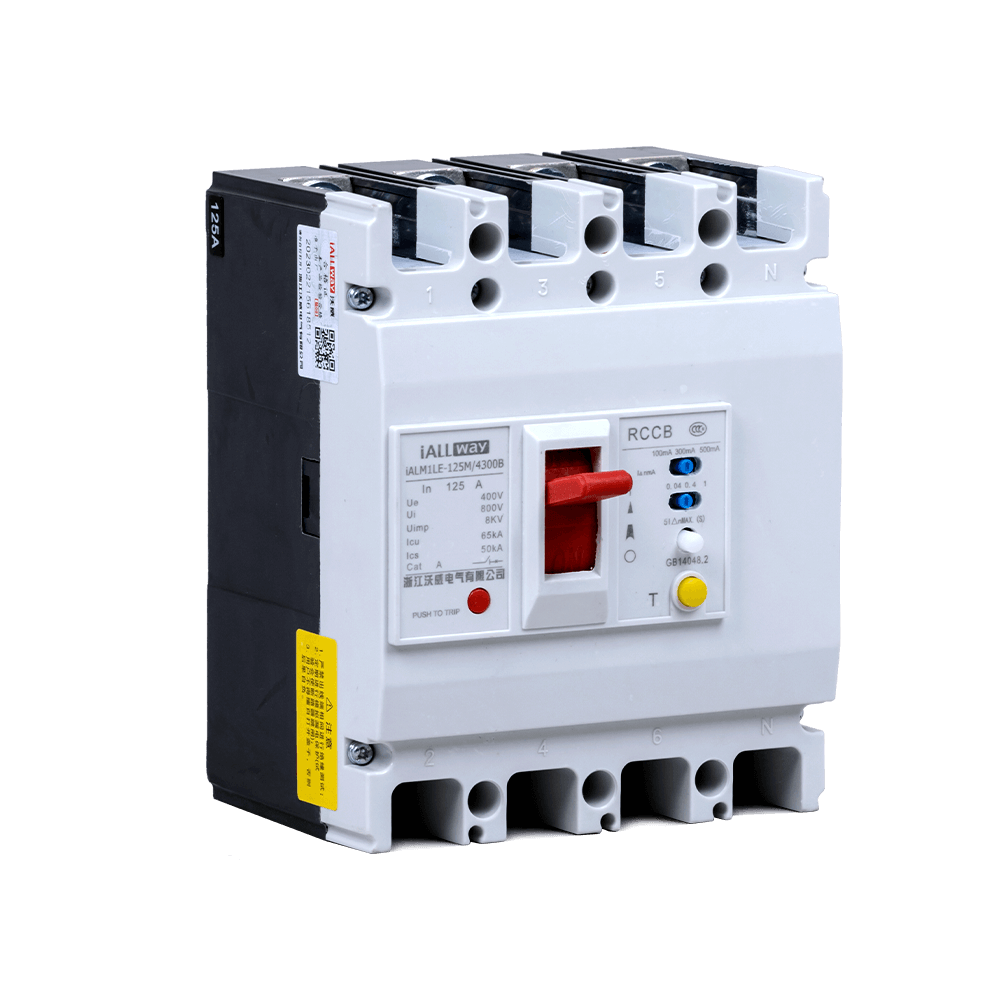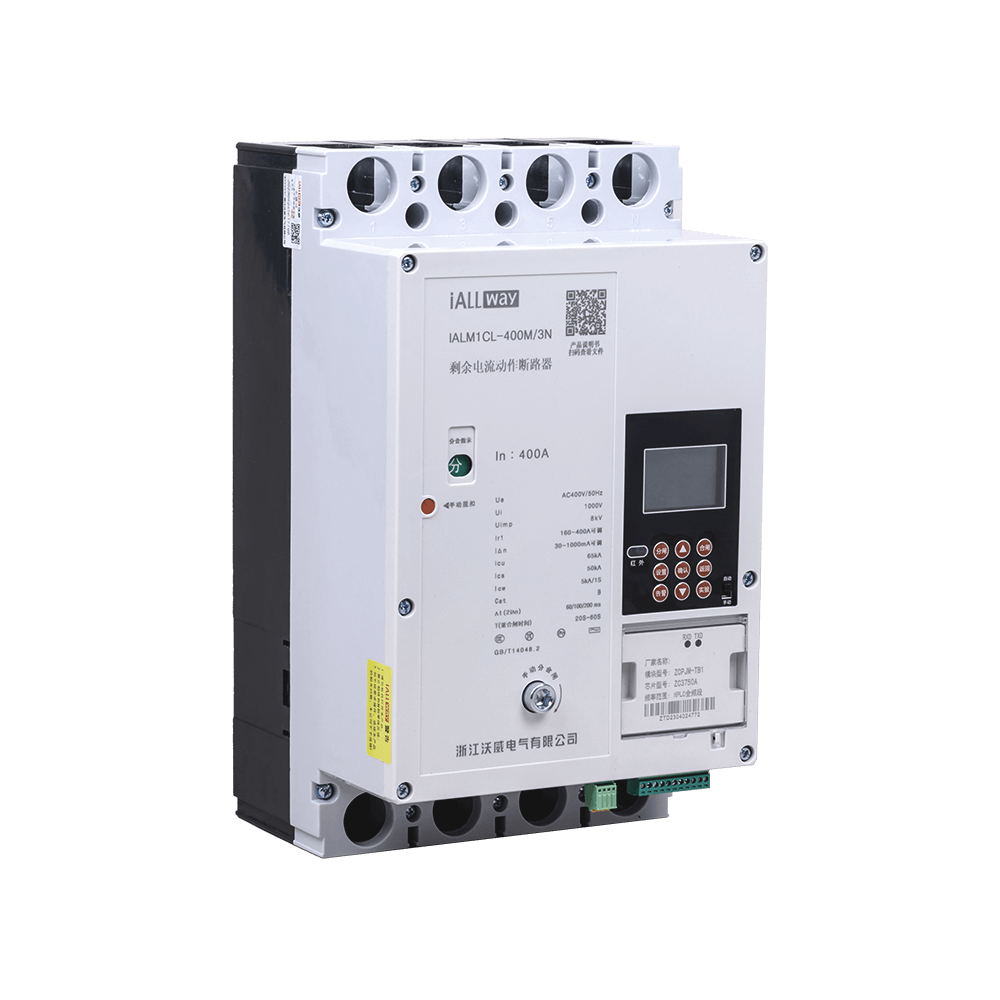Safety and efficiency are two of the major things needed in electrical distribution. Otherwise, it can cause electrical accidents that can harm both people and sensitive equipment.
As a distributor, you want to find the right manufacturer of crucial safety and efficiency components such as Moulded Case Circuit Breakers (MCCB), Residual Current Circuit Breakers (RCCB), Earth Leakage Circuit Breakers (ELCB), and Miniature Circuit Breakers (MCB). If not, you’ll end up distributing subpar breakers that won’t be able to do their job which could ruin your reputation.
The first step is to know the products you’re distributing. In this post, we explain what MCCB, RCCB, ELCB, and MCB are and their differences.

MCCB circuit breakers (Moulded Case Circuit Breakers) are designed to protect against overloads and short circuits. They are suitable for higher current applications (their current rating ranges from 10 amperes to several hundred amperes). They are also known for their large and robust construction due to their higher current-carrying capacity.
Because of this, MCCBs are commonly used in industrial and commercial settings where the demand for electrical power is substantial, such as in distribution boards and electrical panels in factories.
They offer adjustable trip settings allowing for customization based on specific application requirements. This adjustability makes them a perfect choice for a wide variety of applications. An example is in industrial settings where diverse loads and equipment may have varying protection needs.
They are often modular and can be mounted on DIN rails or in switchgear assemblies. They are generally also more expensive than other breakers.
Like MCCBs, Miniature Circuit Breakers or MCBs are devices designed to protect against overcurrents and short circuits. Unlike MCCBs, MCBs have a compact build and are generally more cost-effective than MCCBs.
MCBs are known for their quick response time, ensuring that faults are isolated promptly. They come in various current ratings.
Their small build, however, means they also have lower current ratings which typically range from 1 ampere to 125 amperes. This is why they are mainly used for protecting smaller circuits (they are commonly found in distribution boards within homes and buildings) in residential, commercial, and light industrial installations.
While MCBs have sufficient breaking capacity for most residential and light commercial applications, they may not be suitable for interrupting very high fault currents encountered in heavy industrial environments.
| MCCBs | MCBs |
| Low current ratings | Higher current ratings |
| Residential, commercial, and industrial applications | Residential, commercial, and light industrial applications |
| Adjustable trip settings | Fixed trip settings |
| Protects larger circuits | Protects smaller circuits |
| Higher breaking capacity | Lower breaking capacity |
| Larger and more robust | Compact |
| More expensive | Cost-effective |

RCCBs are specialized devices designed to detect the difference in current between the live (hot) and neutral conductors. They respond to imbalances in the currents, such as those caused by leakage to the ground or through a person.
There are 3 common types of RCCB: AC, A, and A+AC type.
AC type is suitable for detecting and protecting against AC residual currents. A type is more sensitive and can detect both AC and pulsating DC residual currents. A+AC type RCCBs combine features of both AC and A types, making them versatile for various applications.
RCCBs are essential for enhancing electrical safety in residential, commercial, and industrial environments. They quickly disconnect the power supply when they detect a mismatch in the currents flowing through the live and neutral conductors. They are suitable for a broad range of fault detection, including earth leakage and other residual currents.
They are also available in different sensitivity ratings, typically ranging from 10 mA to 300 mA. You can choose the appropriate sensitivity based on the specific application and level of protection required. However, they can’t specifically distinguish between earth leakage and other types of leakage.

Earth Leakage Circuit Breakers (ELCB) are similar to RCCBs in the sense that they both protect against earth faults. However, ELBs are particularly effective in safeguarding against leakage currents to the ground, preventing potential electric shock hazards.
ELCBs are commonly used in residential installations and are available in two types: voltage-operated and current-operated.
Voltage-operated ELCBs are older and less common. They trip when a voltage is induced in the earth wire due to leakage. They have been largely replaced by RCCBs in many applications.
Current-operated ELCBs are more common today and are still used in some specific scenarios. They respond to the current difference between the live conductor and the ground.
Most ELBs have fixed sensitivity, often in the range of 30 mA to 300 mA. However, a few modern ELCBs allow adjustable sensitivity for increased flexibility.
| RCCB | ELCB |
| AC type, A type, and A+AC types | Voltage-operated and current-operated |
| Available in different sensitivity ratings | Fixed sensitivity |
| Suitable for a broad range of fault detection | Voltage-operated ELCBs are almost obsolete, while current-operated ELCBs are still used in some specific scenarios |
The terms RCCB and ELCB are often used interchangeably, but it’s important to recognize that RCCB is a more modern and versatile device that encompasses the functionality of traditional ELCBs.
It activates the trip mechanism when it detects electric flow leakage in the earth wires or going in the ground only. Thus, it needs to be directly connected to an earthing system.
Unlike MCCB and MCB, both RCCB and ELCB do not protect circuits from overcurrent or short circuits. ELCB may tolerate larger current ratings of up to 650 amps, while RCCB’s maximum is 125 amps.
They’re the older RCCB version. Therefore, they might lack advanced materials and features to properly protect the users from other leakage issues. This necessitates extra repairs and maintenance, such as regular or monthly testing, including inspecting the insulation.
Compared to MCB and MCCB, these devices are identical to ELCB because they detect earth electric current, which prevents electric shocks and fires. However, unlike ELCB, it can also sense if electricity travels to the ground from both the live and neutral wires.
The tripping mechanism should be regularly checked to see if it is properly working through the test button, like ELCB. Despite RCCB being less susceptible to dust than their older counterparts, they must be inspected for it on a regular basis and kept away from extreme humidity. This is also because they typically don’t feature sealed enclosures like MCB and MCCB.
MCCBs are devices designed to protect electrical systems from overloads and short circuits. Furthermore, they are intended for applications requiring high electric currents, such as large industries, as they can handle as high as 2500 amps.
Consider noting that they frequently have adjustable trip settings, which are usually not available in other circuit breakers mentioned in this article. Moreover, they can be larger and more expensive than the other three.
MCCB needs regular thermal imaging for maintenance. Because it manages higher electric current that leads to generating more heat and causing damage to the it’s components.
Also protects the system from overloads and short circuits. They’re smaller and preferable in applications where it handles lower electric currents than MCCB. It’s because their possible higher rated current is normally up to 63A. Comparable to MCCB, they don’t also protect people from electric shocks, unlike ELCB and RCCB do.
Both MCCB and MCB do not commonly feature test buttons, as ELCB and RCCB do. So, use specialised equipment like relay test kits to check if the tripping mechanism functions properly.
One of their notable similarities is that their primary purpose is to protect the electrical system from various issues like overloading or short circuits. They do this by automatically disconnecting a circuit when an issue is detected.
Meanwhile, they all required different kinds of testing, such as insulation resistance and trip, as part of their maintenance to guarantee they function properly and trigger the mechanism at the right time to prevent hazards.
Here are some of their other similarities:
All circuit breakers are available in the same number of poles, although certain pole configurations may be more common than others.
An example is iALLWays’ 2 and 4 pole MCCB. That number of poles is also available in other circuit breaker types, including 4 pole RCCB and RCCB 2 pole. If you need more information about iALLWays products, contact them right now and even get a quote. They provide professional advice and reliable options for your electrical system.
As mentioned earlier, these 4 circuit breaker types are available in 1, 2, 3, and 4 poles. Which means you can find circuit breakers of any type that can fit the phase system you had.
For example, RCCB 3 phase and ELCB 3 phase are accessible on the market. Another example is that RCCB single-phase designs feature a phase configuration that is similar to other types, for instance ELCBs and MCCB, which can also have one phase.
One of its primary differences is that MCBs are limited to handling low voltage circuits, while MCCBs can handle higher voltage circuits. This makes the latter ideal for large industrial applications.
As a result, MCB’s current rating is usually up to 125A, but MCCB can range from 15A up to 2500A.
The RCCB can properly work without earthing systems and will activate the trip mechanism whenever it detects electric leakage to the ground.
However, consider attaching an earthing system to the RCCB to ensure additional safety for your electric systems and the people.
When it comes to selecting reliable manufacturers for these critical components, one name stands out: iAllway.
We manufacture high-quality MCCB circuit breakers that undergo rigorous quality assurance processes so that they not only meet but exceed international standards.
With a global presence, iAllway has established itself as a trusted brand in the electrical industry. Distributors can rely on our products to provide top-notch performance and safety.
Contact us today for a quote!
Resources:
Circuit Breaker Operating Temperatures
The Difference Between ELCBs and RCCBs
RCCB Tripping: Causes & Troubleshooting Guide
Difference between MCB, MCCB, ELCB, RCCB, RCBO, RCD And MPCB || why we use this device

Your point of view caught my eye and was very interesting. Thanks. I have a question for you.
I don't think the title of your article matches the content lol. Just kidding, mainly because I had some doubts after reading the article.
Can you be more specific about the content of your article? After reading it, I still have some doubts. Hope you can help me. https://www.binance.com/it/join?ref=S5H7X3LP
Your point of view caught my eye and was very interesting. Thanks. I have a question for you.
Thanks for sharing. I read many of your blog posts, cool, your blog is very good.
Thanks for sharing. I read many of your blog posts, cool, your blog is very good.
It's amazing for me to have a web page, which iis valuable for my experience. thankls admin https://Evolution.org.ua/
Your point of view caught my eye and was very interesting. Thanks. I have a question for you.
Your point of view caught my eye and was very interesting. Thanks. I have a question for you.
Can you be more specific about the content of your article? After reading it, I still have some doubts. Hope you can help me.
Heyya just wanted to give you a brief heads up and let you know a few of tthe pictures aren't loading correctly. I'm not sure whhy but I think its a linking issue. I've tried it in two different internet browsers and both show the same outcome. https://www.waste-ndc.pro/community/profile/tressa79906983/
Thanks for sharing. I read many of your blog posts, cool, your blog is very good.
Your point of view caught my eye and was very interesting. Thanks. I have a question for you.